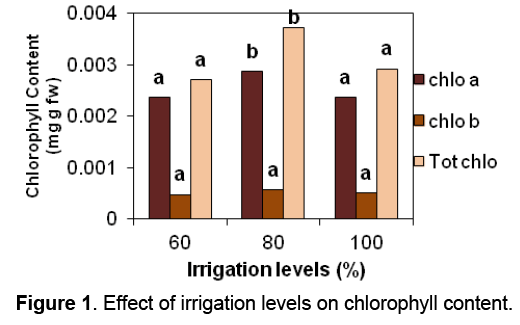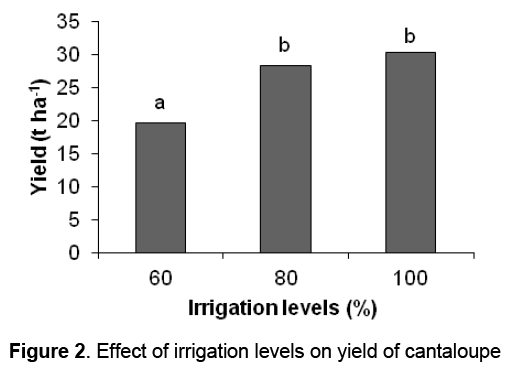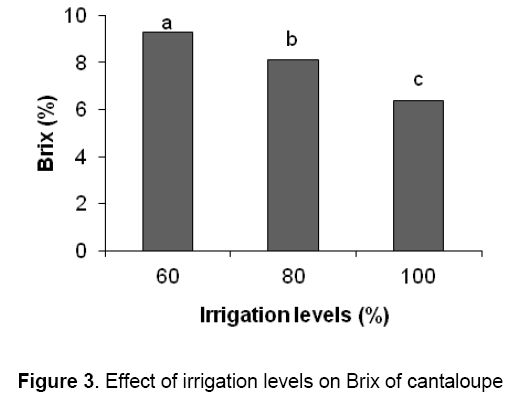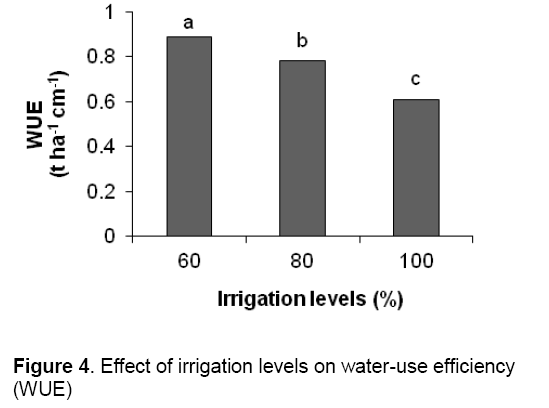Growth, Yield, Yield Components and Water-Use Efficiency in Irrigated Cantaloupes under Full and Deficit Irrigation
Ali Ahmadi-Mirabad, Mahmoud Lotfi, Mahmoud Reza Roozban
Ali Ahmadi-Mirabad*,Mahmoud Lotfi,Mahmoud Reza Roozban
Department of Horticulture,College of Aburaihan,University of Tehran,Pakdasht,Tehran,Iran
Abstract
Water scarcity is a limiting factor for crop production in arid and semi-arid regions. To evaluating effects of deficit irrigation (DI) on growth, yield, yield components and water-use efficiency (WUE) in cantaloupe crop (Cucumis melo L.) under semi-arid conditions, a field experiment based randomized completely block design (RCBD) with three replications was conducted. In this experiment, three irrigation treatments consisted of 60 (I60), 80 (I80), and 100% ETc (I100, Control) were applied during the growing season. Based on the results, the highest total crop yield (30.3 t ha-1), mean number of fruits per plant (4.9), mean fruit weight (1.508 g), plant main stem length (194.6 cm) and total leaf area (24.375 cm2) were obtained in I100, while highest chlorophyll (Chl) a, total Chl content and Chl stability index obtained at I80 treatment. Moderate water stress (I80) did not reduce cantaloupe yield but led to increase WUE and total soluble solids (TSS). Under I60 treatment, the yield was reduced by 35.3% mainly due to decrease of fruit weight, while value of WUE (0.89 t ha-1 cm-1) in this treatment was 45.9% greater than I100. Maximum value of TSS (9.3%) was achieved at I60. Based on the total fruit yield, the preferable level of DI for cantaloupe production is I80, and in region that goal is preserving water resources, I60 treatment, recommended.
Background
Cucumis melo; crop yield; total soluble solids; irrigation; water stress.
1. Introduction
Cantaloupe (Cucumis melo L. var. reticultus ‘Naudin’) is one of the most important vegetable crops in Iran. So that,it lies in fifth place after tomato,cucumber,watermelon and melon,in terms of cultivated area and production.
Climatic conditions of Iran are desirable for cantaloupe production,but water scarcity is a limiting factor for its production [1]. Since,dry and semi-dry regions are comprised about 65% of Iran area,and average rain fall in these areas is less than 150 mm per year [2]. So in Iran drought stress is one of the most important environmental stresses which affect on most growth and physiological aspects of plants and causes huge damages to agriculture products every year [3].
Giving the right amount of water to irrigate the melon is crucial to get maximum yield and save more water for domestic and agricultural purposes. On the one hands,excessive irrigation can damage melon and cause fruit quality problems,leading to reduction of yield,lower fruit quality characteristics and increase sensitivity of plant to fungal diseases [4]. On the other,severe water deficit produces smaller fruits [5],and lower yields in melon [4] and muskmelon [6].
Deficit irrigation (DI) has been widely investigated as a valuable and sustainable production strategy in dry and semi-dry regions. This strategy aims to maximize water productivity and to stabilize yields. DI is successful in increasing water productivity for different crops without causing severe yield reduction [7]. Since the effects of DI on cantaloupe production poorly understood,the present study was,therefore carried out to evaluate the effects of DI levels on crop yield,yield components,total soluble solids (TSS),water-use efficiency (WUE) and growth parameters in drip irrigated cantaloupes.
2. Materials and Methods
Experimental site
The experiment was conducted from June to September,2013 in a research field (35°28' N; 51°41' E; 1021 m) at College of Aburaihan,University of Tehran,Pakdasht,Iran. The research site was located in an semi-arid climate with mean of maximum and minimum temperature of 22.6 and 10.7°C,respectively. The soil of the site was loamy and classified as 'aridisol'. To characterize the properties of the soil,a composite sample (from 5 points) was collected from 0-30 cm depth and analyzed in the laboratory for pH,EC and particle size distribution. Details of soil chemical and physical properties of the site are shown in Table 1.

Experimental Design and Performance: The experiment was laid out as a randomized completely block design (RCBD) with three replications. It comprised of three irrigation treatments including 60,80 and 100% crop evapotranspiration (ETc),to induce a range of water stress from transplanting and harvest stages.
The seeds of ‘Samsouri' -one of the most commercial cultivars of cantaloupe- were sown manually on June 6th,in trays containing peat-moss,under greenhouse conditions. 14-day seedlings were transplanted to the main site. They were randomly distributed on three replicates. The net size of each plot was 6.0 m long and 3.0 m wide. A buffer zone of 3.0 m spacing was provided between plots. Two lines of raised beds in length of 6.0 m were prepared and mulched with plastic polyethylene after installing a drip irrigation system in each plot. The width of the beds was 1.5 m,and the space between plants within rows was considered 50 cm.
Recommended levels of N (450 kg ha-1),P (100 kg ha-1) and K (100 kg ha-1) were used as NPK (20-20-20). Necessary operations such as pests and diseases control were done according to general local practices and recommendations. Also,weeds control was performed,manually.
Irrigation Treatments: The irrigation treatments were applied,from 20 June to 18 September,though the regimes were scheduled weekly. The weekly ETc was calculated from the equation ETc = ETo × Crop Coefficient (Kc) [8]. The ETo was estimated by the Penman-Monteith method [9] using daily data from a meteorological station sited in the experimental field. The crop coefficient (Kc) adopted during the crop season was obtained in previous years in the same conditions. Because the effective rainfall was negligible,the water doses to be applied in each treatment were calculated as the ratio between the ETc of the previous week (net water requirements) and the efficiency of the system estimated at 0.81 [10]. This result was divided by the number of days to obtain the daily irrigation requirements. The control of the amount of water supplied,and thus the deviations of the true amount applied from the planned,was made using water meters installed at the outflow of each electro-valve supplying the water for each treatment.
Traits Investigated: Plant heights and total leaf area were the growth parameters measured after 90 days (the end of vegetative growth) from transplanting date. Total leaf area of the plant was measured by a Leaf Area Meter (AM 200,ADC Bio Scientific Ltd. UK). Chl concentration was calculated using methods described by Ronen and Galun [11] and based on following equations:
Chl a(gr/l)=(0.0127)(OD663)-(0.00269)(OD645)
Chl b(gr/l)=(0.0229)(OD645)-(0.00468)(OD663)
Total Chl(gr/l)=(0.0202)(OD645)+(0.00802)(OD663)
OD: Optical Density
The Chl stability index (CSI) was determined according to Sairam et al. [12] and calculated as follows:

To measure the leaf Relative Water Content (RWC),Water Saturation Deficit (WSD),Leaf Water Content (LWC) and leaf water content per unit leaf area (LWCA),three leaves was sampled from one plant per plot. Then,the leaves were wrapped immediately in aluminum foil,put in a plastic bag and kept in a cool place. Fresh weight was determined one h after cutting. Turgid weight was determined as follows: the leaves were held in distilled water at room temperature (approximately 4°C) for 24 h; then,they were quickly and carefully dried by tissue; and their turgid weight was determined; next,the samples were then dried in an oven at 70°C for 24 h and weighed [13]. Finally,RWC,WSD,LWCA and LWC were calculated using the following equation:

Where,FW,DW,TW and L are fresh weight (g),dry weight (g),turgid weight (g) and leaf area (cm2) respectively.
The harvests started when fruits were fully mature. Total two pickings of cantaloupe were taken (15 and 20th September) and standard procedures were adopted for recording the data on crop yield and yield components. The main yield components recorded in this study were mean number of fruits per plant (MNFPP),mean fruit weight (MFW),total crop yield (TCY),total soluble solid (TSS) content,and WUE. MNFPP were measured by harvesting fruits of each plot. Each cantaloupe fruit was weighed in each harvest to determine MFW. TSS was determined from three samples taken randomly from harvested fruits of each plot. From the liquid extract obtained by liquefying the mesocarp of each fruit,the TSS was measured by a handheld Refractometer (Garl Zeiss,Germany) and expressed as Brix. The weights of fruits from each plot were recorded at each peaking. Then,the TCY and WUE were determined for all treatments. The effectiveness of any crop to use water during its complete growth period is generally described in terms of WUE and is expressed as ratio of total crop yield to total of water applied to crop including effective rainfall during its complete growth period [14]. At the end,WUE were calculated using the formula:

Where: CY = total crop yield,t ha-1; WA = total of water applied,cm-1.
Statistical Analyses: All data were analyzed statistically using a two-way ANOVA (SAS ver. 9.1) and Duncan's multiple range test (P<0.05) was used to determine significant differences among treatments.
3. Results and Discussion
Our results showed that,DI significantly affected plants main stem length,total leaf area,Chl content,Brix,CSI,MNFPP,MFW,TCY,and WUE. DI had a negative significant (p<0.01) effect on plant main stem length. The highest (194.7 cm) and lowest (102.3 cm) main stem length was recorded with I100 and I60 treatments,respectively (Table 2).

Accordingly irrigation level at I100,increased significantly (p<0.01) the plant leaf area (24375 cm2) than the other two irrigation levels,whereas decreased total leaf area under DI treatments (15241 and 10109 cm2 at I80 and I60,respectively) (Table 2).
The obtained results are generally similar to results found by Badr [15],Keshavarzpour and Rashidi [16] on cantaloupe and Cabello et al. [17] on melon. The main reason for reducing of stem height is usually decreasing leaching fraction,due to a reduction of the available water on active root-zone,which caused a disturbance in the physiological processes needed for plant growth.
DI can also alter the tissue concentrations of chlorophylls. In our DI treatments,the I80 significantly (p<0.05) increased CSI (145.73%),Chl a content (0.0029 mg g-1) and total Chl content (0.0037 mg g-1),while lowest CSI (87.2 %),Chl a content (0.0023 mg g-1) and total Chl content (0.0027 mg g-1) obtained at I60 (Table 2 and Figure 1).
Increased Chl content under moderate DI may be related to a decrease in leaf area. It can be a defensive response to reduce the harmful effects of drought stress [18]. Reduction of Chl content under higher water deficit further reported in Vaccinium myrtillus [19] and in sunflower plants [20].
The maximum values of MNFPP (4.9) and MFW (1508 g) were obtained by I100 treatment,while minimum value of NFPP (2.1) and MFW (1067 g) were noted in case of I60. However,the difference between 100 and 80% ETc was not significant (Table 2).
Also,irrigation levels significantly (p<0.01) affected TCY in the order of 100% > 80% > 60% ETc. The TCY was ranging between 30.3 t ha-1 for I100 and 19.6 t ha-1 for I60 (Figure 2 ).
The decrease in cantaloupe yield in the severe DI treatment was due to a decrease in fruit weight and fruit number. These evidences showed that cantaloupe is not very sensitive to moderate water deficits up to 20% of the ETc,but a water deficit of 40% can reduce yield by 35.3%. The favorable results which were obtained from the mentioned levels (I80 and I100) might be due to adequate available soil moisture within the root-zone. This led to increase the various physiological processes as better uptake of nutrients,good plant growth,higher rates of photosynthesis,excess of dry matter accumulation which reflect and led to the best yields [21,22,23]. It was reported that increase of both auxins and gibberellins levels within the biological concentrations,promote cell division and cell size enlargement; hence,increase vegetative growth [24]. Conversely,it seems that the lower values of crop yield and yield components recorded in case of 60% ETc might be due to infrequent application of water resulting in lack of moisture in active crop root-zone,inadequate moisture conservation and poor utilization of nutrients.
TSS is an important factor in the appreciation of the flavour of cantaloupe [21,16]. The values of fruit TSS ranged from 6.4% (in I100) to 9.3% (in I60). The highest value of TSS was found in treatment I60 (Figure 3 ).
Under water deficit conditions,amount of starch reduced but amount of Brix increased,perhaps due to reduction of fruits number [25]. In other studies,TSS increased with decreasing amount of irrigation,too [17,6].
This experiment shows that water was used more efficiently in the DI treatments. Our results indicated that DI markedly increased WUE. Highest WUE (0.89 t ha-1 cm-1),were obtained in treatment irrigated based on I60 and lowest (0.61 t ha-1 cm-1) at I100 (Figure 4 ),because this treatment consumed less water than the other treatments.
This result was consistent with researches Ertek et al. [26] on summer squash and Al-Mefleh et al. [27] on melon that cited irrigation levels with higher amounts of water generally have lower WUE values. Also,result of the current study was supported by findings of Fabeiro et al. [28] on muskmelon,Ribas et al. [29] in melon and Zotarelli et al. [30] in zucchini squash.
We found that RWC,LWCA and LWC decreased under DI,while WSD increased but with no significant differences between DI levels (Table 3). Although,most studies have shown decreased RWC,LWCA,LWC and increased WSD in responses to drought stress [31,32].
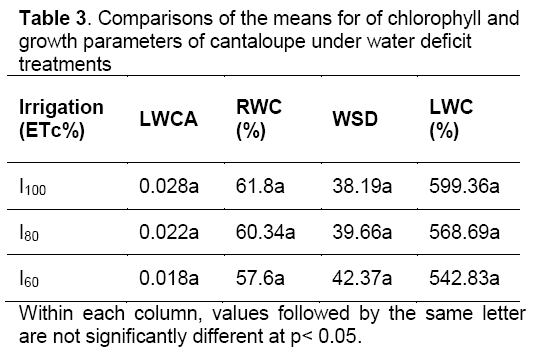
4. Conclusions
Since the water scarcity is a key factor for plant production under arid and semi-arid regions,thus achieving great values of WUE is more reasonable than maximum yield. WUE in I60 was 45.9% greater than full irrigation treatment,while maximum value of TCY was only 35.3% greater than achieved yield in I60 treatment. Our results showed that moderate DI (I80) did not reduce cantaloupe yield but led to increase WUE and TSS. According to these results,in region that the goal is to achieve higher yield,I80,and in region that goal is preserving water resources,I60,recommended.
Acknowledgements
The authors are grateful from Mohammad Soltani for his assistance in preparing the manuscript..
References
- Anonymous. 2004. Annual Agricultural Statistics. Ministry of Jihad-e-Agriculture of Iran. [Online] Available at https:// www.maj.ir.
- Eslamian S.,Soltani S. (2002) Plenty Analysis of flood (Translation). Arkan Pub. pp 344.
- Alizadeh A.,Alizade V.,Nassery L.,et al. (2011) Effect of drought stress on apple dwarf rootstocks. Tech. J. Engine. Appl. Sci,1: 86-94.
- Sensoy S.,Ertek A.,Gedik I.,et al. (2007) Irrigation frequency and amount affect yield and quality of field grown melon (Cucumis melo L.). Agricultural Water Management,88: 269-274.
- Long R.L.,Walsh K.B.,Midmore D.J. (2006) Irrigation scheduling to increase muskmelon fruit biomass and soluble solids concentration. Horticulture Science,41: 367–369.
- Kirnak H.,Higgs D.,Kaya C.,et al. (2005) Effects of irrigation and nitrogen rates on growth,yield,and quality of muskmelon in semiarid regions. Plant Nutrition Journal,28: 621-638.
- Geerts S.,Raes D. (2009) Deficit irrigation as an on-farm strategy to maximize crop water productivity in dry areas. Agricultural Water Management,96:1275-1284.
- Doorenbos J.,Pruitt W.O. (1974) Crop water requirements. Irrigation and drainage paper no. 24. Food and Agriculture Organization,Roma.
- Allen R.G.,Pereira L.S.,Raes D.,et al. (1998) Crop evapotranspiration: guidelines for computing crop water requirements. Irrigation and Drainage Paper no 56,Available at https://www.fao.org.
- Rinco N.L.,Gimenez M. (1989) Fertirrigacion por goteo in melon. Fertilizacion,105: 55-66.
- Ronen R.,Galun M. (1984) Pigment extraction from lichens with dimethyl sulfoxide (DMSO) and estimation of chlorophyll degradation. Environmental Experiment Botany,24:239-245.
- Sairam R.K.,Deshmukh P.S.,Shukla D.S. (1997) Tolerance of drought and temperature stress in relation to increased antioxidant enzyme activity in wheat. Journal Agronomy. Crop Science,178: 171-178.
- Ritchie S.W.,Nguyen H.T. (1990) Leaf water content and gas exchange parameters of two wheat genotypes differing in drought resistance. Crop Science,30: 105-111.
- Jain N.,Chauhan H.S.,Singh P.K.,et al. (2000) Response of tomato under drip irrigation and plastic mulching. In: Proceeding of 6th International Micro-irrigation Congress,Micro-irrigation Technology for Developing Agriculture. South Africa 22-27 October 2000. 2000pp 1-6.
- Badr M.A. (2007) Spatial distribution of water and nutrients in root zone under surface and subsurface drip irrigation and cantaloupe yield. World Agriculture Science,3: 747-756.
- Keshavarzpour F.,Rashidi M. (2011) Response of crop yield and yield components of cantaloupe to drought stress. World Applied Science Journal,15: 382-385.
- Cabello M.J.,Castellanos M.T.,Romojaro F.,et al. (2009) Yield and quality of melon grown under different irrigation and nitrogen rates. Agricultural Water Management,96: 866-874.
- Farooq M.,Wahid A.,Kobayashi N.,et al. (2009) Plant drought stress: effects,mechanisms and management. Agronomy Sust. Development,29: 153-188.
- Tahkokorpi M.,Taulavuori K.,Laine K.,et al. (2007) After-effects of drought related winter stress in previous and current year stems of Vaccinium myrtillus L. Environmental Experiment Botany,61: 85-93.
- Kiani S.P.,Maury P.,Sarrafi A.,et al. (2008) QTL analysis of chlorophyll fluorescence parameters in sunflower (Helianthus annuus L.) under well-watered and water stressed conditions. Plant Science,175: 565-573.
- Gaafer S.A.,Refaie K.M. (2006) Modeling water effects on growth and yield of melon (Cucumis melo cv. Reticulotus). Egypt Journal Applied Science,21 (8B).
- Rashidi M.,Seyfi K. (2007) Effect of water stress on crop yield and yield components of cantaloupe. International Journal Agricultural Biology,9: 271-273.
- Simsek M.,Comlekcioglu N. (2011) Effects of different irrigation regimes and nitrogen levels on yield and quality of melon (Cucumis melo L.). African Journal Biology,10: 10009-10018.
- Refaie K.M. (2003) Studies on controlling soil moisture within root zones to minimize water loss to the surrounding environment. [M. Sc. Thesis.] Institute of Environmental Studies and Research. Ain Shams University. Cairo,Egypt: 85-89.
- Oliviera-Neto C.F.,Silva-Lobato A.K.,Goncalves-Vidigal M.C.,et al. (2009) Carbon compounds and chlorophyll contents in sorghum submitted to water deficit during three growth stages. Science Technology,7: 588-593.
- Ertek A.,Sensoy S.,Kucukyumuk C.,et al. (2003) Irrigation frequency and amount affect yield components of summer squash (Cucurbita pepo L.). Agricultural Water Management,67:63-76.
- Al-Mefleh N.K.,Samarah N.,Zaitun S.,et al. (2012) Effect of irrigation levels on fruit characteristics,total fruit yield and water-use efficiency of melon under drip irrigation system. Journal of food,Agriculture and Environment,10: 540-545.
- Fabeiro C.,Martin F.,De Juan J.A. (2002) Production of muskmelon (Cucumis melo L.) under controlled deficit irrigation in a semi-arid climate. Agricultural Water Management,54: 93-105.
- Ribas F.,Cabello M.J.,Moreno M. (2003) Influencia del riego y de la aplicacion de potasio en la produccion del melon (Cucumis melo L.). II: Calidad. Spanish Journal Agriculture Research,1: 79-90.
- Zotarelli L.,Dukes M.D.,Scholberg J.M.,et al. (2008) Nitrogen and water-use efficiency of zucchini squash for a plastic mulch bed system on a sandy soil. Horticulture Sciences,116: 8-16.
- Terzi R.,Kadioglu A. (2006) Drought stress tolerance and antioxidant enzyme system in Ctenanthe setosa. Acta Biological Cracoviensia Series Botanical,48: 89-96.
- Bayoumi T.Y.,Eid M.,Metwali E.M. (2008) Application of physiological and biochemical indices as a screening technique for drought tolerance in wheat genotypes. African Journal Biotechnology,7: 2341-2352.

Open Access Journals
- Aquaculture & Veterinary Science
- Chemistry & Chemical Sciences
- Clinical Sciences
- Engineering
- General Science
- Genetics & Molecular Biology
- Health Care & Nursing
- Immunology & Microbiology
- Materials Science
- Mathematics & Physics
- Medical Sciences
- Neurology & Psychiatry
- Oncology & Cancer Science
- Pharmaceutical Sciences
